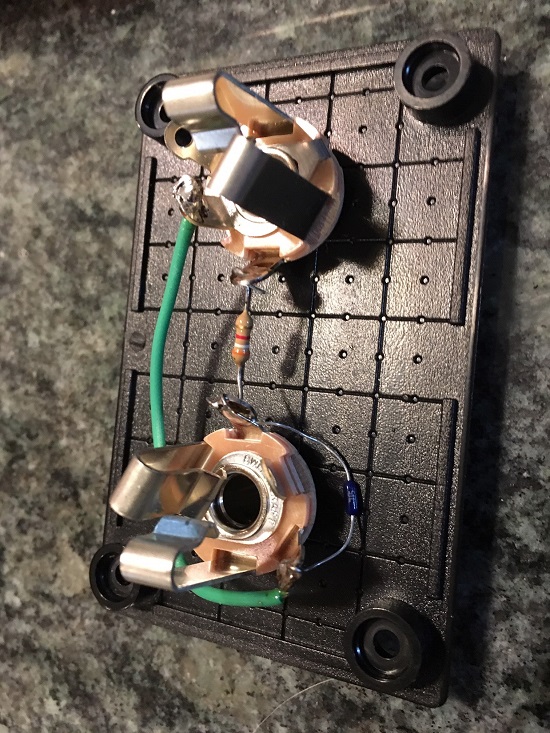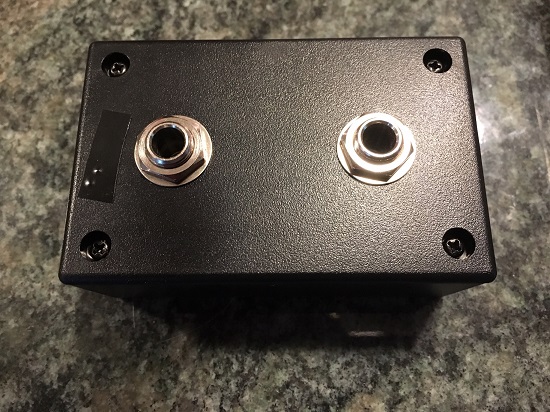This is topic Line Level Audio Output From a Kodak Pageant in forum 16mm Forum at 8mm Forum.
To visit this topic, use this URL:
https://8mmforum.film-tech.com/cgi-bin/ubb/ultimatebb.cgi?ubb=get_topic;f=5;t=002033
Posted by Steve Klare (Member # 12) on October 22, 2019, 08:33 AM:
Over the weekend I finally fixed a gap Iíve had in my home cinema for about two years now: I finally got my Kodak Pageant working through my sound system like all my other projectors.
The Pageant is probably best described as an institutional projector: traditionally, you wheel it in on a steel cart in front of your high school biology class, Scout troop or Friday night film appreciation society, you unfurl about 15 feet of orange wire and plug the case cover mounted speaker into a ľĒ jack on the machine chassis and then put the speaker up by the screen.
It is simple, ruggedÖ.in no way sexy! Itís a projector made for people who just wanted to show the film, rewind it and then head to lunch! Itís a lot closer to an Army Jeep than to a Ferrari. (Yet, I have a feeling it will survive us all!)
There is no internal speaker, and (for me) even worse: no line level Aux. output.
This is my first 16mm machine. My entire sound system revolves around line-level signals plugged into my mixer. Itís what Iíve used for Super-8 and digital projection too.
Iíve been living with the usual Pageant scheme of things for a while: I grab that speaker and start casting out orange wire like Iím about to set off some dynamite. I donít have enough rope to reach all the way to the screen, so the sound comes out between the projector and the audience. Itís a single, simple speaker with nothing but volume and tone control. Iíve contented myself with it while I solved other, often bigger problems and in the meantime gave this problem some thought.
I came up with a wonderful, complicated scheme to fix this, which in the end turned out to be a 50-dollar cure to a 5-dollar illness. There was going to be all sorts of active op-amp based circuitry. I was going to start it with a dummy load of something equal to or greater than 8 Ohms and take the voltage from that, attenuate it, clean it up and offer up a nice line level signal referenced to ground on my mixer. There would be an external power supply, some sort of heatsink and maybe even a fan! Iíd find some excuse to mount LEDs on the case, for sure!
Before I ordered even a single part, I started to see the Rube Goldberg-ness in all this. It was too much cost, effort, complication, and required too much thought during setup (ďWhat can go wrong WILL go wrong!Ē). It was time to start over from a blank sheet and this time keep it simple.
Other projectors have Aux outputs without all this fuss! How do THEY do it?
If you take off the rear panel of an Elmo ST-1200HD, you can see their Aux output in all its humble glory. It starts at the amplifier output, where the internal speaker also connects. Itís a bigger resistor, then comes the tip of a 3.5mm monaural jack, then a smaller resistor, then the sleeve of that same jack and finally ground. The jack has a switch that disconnects the speaker while the Aux is plugged in.
-Deadly simple: maybe two bucks worth of parts and for a machine with no internal speaker it wouldnít even need the switch. No power supply, no heatsink, no fan and nothing else to plug into a crowded barrier strip and many fewer hours soldering, fabricating and troubleshooting.
-I wanted that!
I faked this with two resistors stapled to a piece of cardboard and every clip lead I could round up. I liked the way it sounded, and I behaved myself by not making the cardboard kludge my permanent setup (I think I still owe at least one high school teacher some term paper or otherÖ). A couple of weeks ago I bought a bunch of parts for projects including the parts to do this one right and on Saturday kept my self-promise to build it after we got home from CineSea.

Itís just this simple: two ľĒ jacks in a black plastic case with two resistors (3900 Ohms and 715 Ohms, total output impedance 600 Ohms: just like an Elmo ST). The input is tip and sleeve, but the output is tip and ring. This is because my mixer accepts balanced inputs (isolated ground) to prevent ground loops among the several devices plugged in.
I keep fighting the urge to complicate this thing: maybe stick in a capacitor somewhere to filter outÖsomething. With the other signal processing equipment I have downstream there is really no need. Since itís impossible to tell one jack from the other with the case closed, my wife made me labels for input and output: thatís all it really needed!
Just for a little style, the cable between the projector and the box is a nice looking braided monaural electric guitar cord with metal cased plugs. The cable between the box and the mixer is a stereo patch cable. The joy of this is if the Pageant was ever the only machine plugged into the mixer, I could swap the monaural and stereo cables input/output and it would change the balanced mixer input into an unbalanced one in order to ground the mixer through the Pageant.
Whatís useful here is this should be able to take any speaker level output from a transistorized amplifier and make it line level. It could be no more complicated than soldering up a new input cable with the right projector connection.
-best of all: after I was done, I ran a bunch of my 16mm prints and really enjoyed the improved sound!

Posted by Barry Fritz (Member # 1865) on October 22, 2019, 12:23 PM:
Nice work Steve!
Posted by Janice Glesser (Member # 2758) on October 22, 2019, 04:05 PM:
Great Steve! I'm a firm believer in K.I.S.S. you are successfully moving along in your 16mm journey.
Posted by Steve Klare (Member # 12) on October 22, 2019, 05:51 PM:
Thanks!
Albert Einstein is quoted saying "Everything should be made as simple as possible, but no simpler.".
-which is strange, because to me that sounds more like Yogi Berra! (They both lived in New Jersey: maybe they hung out!)
Because of how small the resistors are, I think it should be possible to build a cable with them hidden inside the jack covers. You'd have to make it obvious which end is which, because if you flipped ends it wouldn't work right.
It would also be impossible to change back and forth between a balanced/unbalanced connection.

Visit www.film-tech.com for free equipment manual downloads. Copyright 2003-2019 Film-Tech Cinema Systems LLC

UBB.classicTM
6.3.1.2


